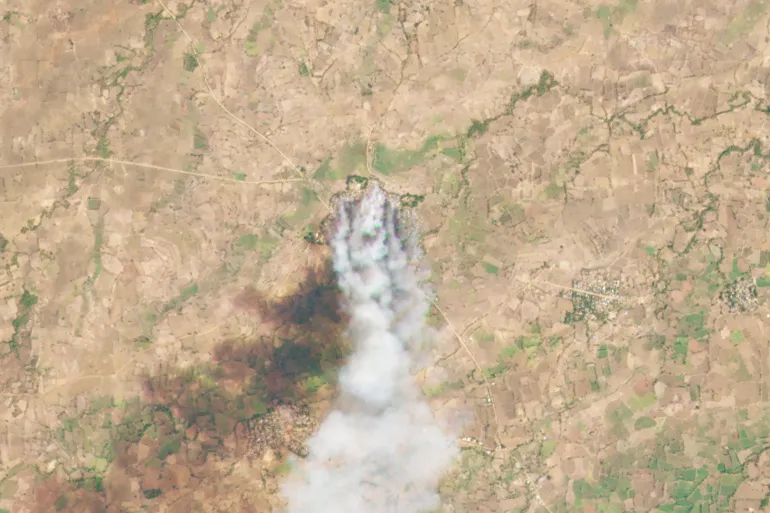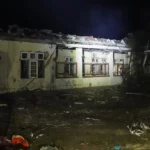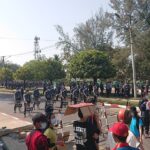
Myanmar Paraglider Attack Leaves Dozens Dead in Chaung-U Township
A Night of Tragedy in Central Myanmar
At least 24 people were killed and nearly 50 others injured when Myanmar’s military carried out a deadly aerial assault using motorised paragliders during a candlelight vigil in Chaung-U Township, located in the Sagaing Region of central Myanmar.
According to officials from the National Unity Government (NUG), the attack occurred on Monday evening as a crowd of roughly 100 residents gathered to celebrate a Buddhist festival and call for the release of political prisoners.
Witnesses told local outlets that a paraglider dropped two improvised bombs directly over the group before circling back for another pass hours later. The explosions tore through the crowd, scattering bodies and leaving scores wounded.
Two Waves of Bombings
The strikes came in two separate waves — the first at approximately 8 p.m. local time (13:30 GMT), and the second just before 11 p.m. (16:30 GMT).
Reports from The Irrawaddy, an independent news outlet based in Thailand, said the initial blast killed more than 20 people instantly, while the second wave added to the devastation as rescuers tried to help survivors.
Amnesty International, citing field sources, confirmed that the attacks deliberately targeted civilians and described them as part of a “long-running campaign of terror” against communities opposing military rule.
Human Rights Groups Condemn the Strike
“This would be the latest in a long line of attacks that stretch back almost five years to the start of the 2021 military coup,” said Joe Freeman, Amnesty International’s Myanmar researcher.
He added that as the junta prepares for what he called a “stage-managed election” later this year, it is intensifying its brutal campaign to crush resistance across the country.
The UN Human Rights Office said the use of motorised paragliders to drop munitions is a known tactic of Myanmar’s armed forces, used to bypass anti-aircraft defenses and strike gatherings in rural areas.
A Nation Still at War
Myanmar has been in a state of civil war since the army seized power in February 2021, overthrowing the elected government of Aung San Suu Kyi.
The coup triggered a nationwide uprising, and the military’s violent crackdowns created a growing alliance of ethnic armed organisations (EAOs) and pro-democracy resistance groups.
According to UN figures, more than 75,000 people have been killed and over 3 million displaced since the conflict began.
Entire villages have been destroyed, and airstrikes against civilian populations are now common in contested regions like Sagaing, Chin, and Kayah States.
Military Losses and Renewed Offensives
A 2024 BBC investigation estimated that the junta controls about 20 percent of the country’s territory, while opposition and ethnic forces control roughly 40 percent, leaving the rest fiercely contested.
After months of losing ground, the military has launched renewed offensives in 2025, relying heavily on airstrikes, artillery bombardments, and remote attacks like those seen in Chaung-U.
Analysts say the strategy is designed to reclaim key areas before the junta’s proposed elections later this year — a vote widely dismissed by international observers as neither free nor fair.
The Scene in Chaung-U
Residents of Chaung-U described a night of fear and confusion. The small township, known for its Buddhist monasteries and farming communities, was illuminated by candlelight as villagers observed a religious festival.
Without warning, the first bomb exploded in the center of the crowd, followed by a second detonation near the pagoda entrance. Witnesses said fragments of shrapnel struck homes, killing children and elderly residents.
“We saw fire everywhere,” said one survivor interviewed by local media. “People were screaming for help. We never thought the military would attack during a religious event.”
Medical volunteers who attempted to reach the wounded said roads were blocked by soldiers, forcing them to transport victims by motorbike and handcart to nearby clinics.
Global Condemnation and Calls for Action
Amnesty International and the United Nations Human Rights Council have condemned the attack as a possible war crime, urging the UN Security Council to refer Myanmar’s situation to the International Criminal Court (ICC).
“The UN and ASEAN must increase pressure on the junta and revise an approach that has failed the Myanmar people for almost five years,” Freeman said.
He called on neighbouring governments, including Thailand and India, to stop enabling the flow of weapons and fuel that sustain the military’s campaign.
The government-in-exile known as the National Unity Government echoed Amnesty’s call, describing the Chaung-U assault as a “massacre” and demanding an immediate global embargo on jet fuel and aviation parts destined for the Myanmar Air Force.
ASEAN’s Limited Influence
The Association of Southeast Asian Nations (ASEAN) has struggled to broker peace since adopting a five-point consensus in 2021 calling for dialogue and an end to violence.
Member states such as Indonesia and Malaysia have pushed for stronger measures, while others — notably Thailand and Cambodia — maintain limited engagement with the junta.
International critics, including the Japanese government, argue that no credible election can take place without a cease-fire and genuine political dialogue.
Until then, analysts say, any vote will serve only to entrench military rule under a façade of civilian participation.
Humanitarian Crisis Deepens
Beyond the battlefield, Myanmar’s humanitarian situation continues to worsen.
UN agencies estimate that 17 million people now require aid, and displaced families in Sagaing Region face shortages of food, medicine, and shelter.
Internet shutdowns, road blockades, and military checkpoints prevent relief convoys from reaching those most in need.
Community-based networks — often the same groups targeted in attacks like Chaung-U — have become the backbone of local relief efforts. Volunteers risk arrest and airstrikes to deliver rice, water, and medical supplies to isolated villages.
Voices from the Ground
Local activists say the paraglider attack highlights a disturbing evolution in the military’s tactics.
“In the past, we feared jet bombings,” said one coordinator with a civil-society group in Sagaing. “Now they use paragliders — silent, low, unpredictable. It’s pure terror from the sky.”
Eyewitness videos shared online showed flashes of light over Chaung-U’s skyline followed by plumes of smoke. The footage could not be independently verified, but human-rights monitors confirmed that similar paraglider assaults occurred in neighboring townships earlier this year.
A Nation in Need of Accountability
Nearly five years after the coup, hopes for accountability remain fragile.
Despite multiple UN resolutions and targeted sanctions by the US and EU, the military leadership continues to operate with impunity.
Analysts warn that without coordinated global action, Myanmar risks sliding deeper into protracted conflict.
“The world must not turn away,” said a statement from the NUG. “Every attack on civilians — from airstrikes to paragliders — demands justice. The people of Myanmar continue to suffer while the international community hesitates.”
Looking Ahead
As 2025 approaches, the junta’s pledge to hold elections remains overshadowed by escalating violence.
For millions of displaced citizens, the promise of peace feels distant.
Chaung-U’s tragedy stands as yet another reminder that Myanmar’s crisis is far from over — and that without sustained international pressure and genuine reconciliation, the cycle of suffering will persist.
Conclusion
The Chaung-U Township attack marks one of the deadliest incidents in Myanmar this year.
With dozens killed, scores injured, and communities left in mourning, it underscores the military’s continued reliance on air power and terror tactics to maintain control.
As global attention shifts to other conflicts, Myanmar’s people remain caught between resistance and repression — waiting for justice, accountability, and lasting peace.
Frequently Asked Questions
What happened in Chaung-U Township?
Motorised paragliders dropped explosives on a civilian gathering in Chaung-U Township, Sagaing Region, killing dozens and injuring many.
When did the attack occur?
The assault happened on Monday evening in two waves — around 8:00 p.m. and again at 11:00 p.m. local time.
How many casualties were reported?
Initial reports confirmed at least 24 dead and 47 wounded, though local sources suggest higher numbers.
Who is alleged to be responsible?
Human-rights monitors attribute the strikes to Myanmar’s military, which has used paragliders and airstrikes in the ongoing conflict.
Why was a crowd gathered in Chaung-U?
Residents held a candlelight vigil during a Buddhist festival to call for peace and the release of political prisoners.
What has been the international response?
Amnesty International and UN agencies condemned the attack and urged stronger global action, including referral to the International Criminal Court.
What is the broader context of Myanmar’s conflict?
Since the 2021 coup, clashes between the military, resistance forces, and ethnic armies have killed tens of thousands and displaced millions nationwide.
Related posts:
 U.S. Ends Temporary Protected Status for Myanmar Nationals
U.S. Ends Temporary Protected Status for Myanmar Nationals
 More than 120 Myanmar nationals repatriated as hostilities ease in Kayin State.
More than 120 Myanmar nationals repatriated as hostilities ease in Kayin State.
 Myanmar Workers Arrested in Bangkok and Chiang Mai Restaurants
Myanmar Workers Arrested in Bangkok and Chiang Mai Restaurants
 China Issues Wanted Notices for 100 Myanmar Scam Suspects
China Issues Wanted Notices for 100 Myanmar Scam Suspects
 Airstrike Destroys Mrauk U Hospital in Rakhine, Dozens Injured
Airstrike Destroys Mrauk U Hospital in Rakhine, Dozens Injured
 RIGHTS GROUPS DEMAND MYANMAR JUNTA END CHILD SOLDIER PRACTICE
RIGHTS GROUPS DEMAND MYANMAR JUNTA END CHILD SOLDIER PRACTICE
